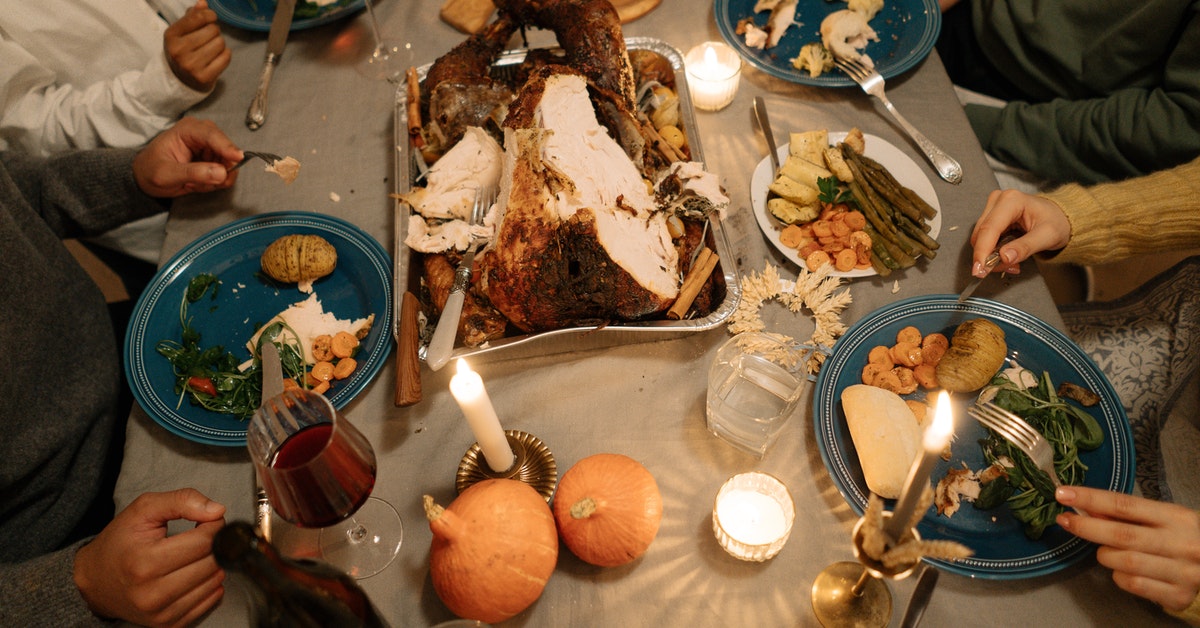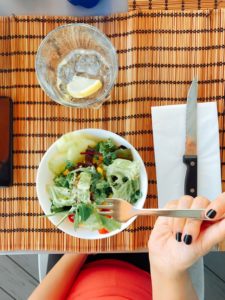The holidays are always a challenging time for those who are trying to stick to a healthy diet. This year, many people have also been struggling with boredom and stress-eating during quarantine, making the upcoming holiday season a double whammy. Here are five tips on how to keep from overeating this winter:

1. Don’t Keep Junk Food In the House
Nowadays, you are probably at home more often than not, and when you’re feeling snackish, you can easily reach into the cupboard for something satisfying. If you find yourself reaching for potato chips, sugary treats, or other high calorie, low nutrition foods, there’s a simple way to stop. Don’t buy them. Yes, it takes some self-control at the grocery store, but it’s well worth it. Stock up on healthy snacks like nuts, protein drinks, fruits, and veggies. That way, when you need that afternoon snack, you’ll have no choice but to reach for something healthy.
Beware of liquid snacks as well. Soda has tons of calories and sugar, and even diet varieties contain chemicals that promote weight gain. Studies have shown that if a regular soda drinker cuts soda out of their diet and changes nothing else about the way they eat, they’ll lose thirty pounds in a year. That’s a lot of weight from just one change! If you need an afternoon pick-me-up, consider coffee or tea. These options have no calories (on their own) and even have health benefits. Coffee and black and green tea all contain antioxidants that can help protect you against diabetes, heart disease, and certain cancers. Green tea also contains L-theanine, an amino acid that helps improve mood and cognition and can ease anxiety symptoms.
If you enjoy snack bars but need a cheaper, lower-calorie option, just search the internet. There are tons of easy, no-bake recipes for homemade snack bars that are satisfying and healthy. Most of them require a few simple ingredients like nut butter, honey, and fun add-ins like craisins or chocolate chips. Dark or semi-sweet chocolate added to a snack bar doesn’t add too much sugar and can be beneficial. Dark chocolate contains flavonoids that have many of the same benefits as the antioxidants in coffee and tea. It’s also a good source of magnesium. A mineral many people are deficient in.
2. Don’t Take Seconds
It can be tempting to take seconds when one of your favorite dishes is on the table, and from time to time, there’s nothing wrong with that. But if you’re in the habit of taking seconds at nearly every meal, you could lose weight by breaking that habit. This is especially a problem for many folks over the holidays when we serve foods that we don’t serve at other times of the year. Overeating on Thanksgiving Day and Christmas Day won’t do too much harm if you use moderation the rest of the time. Look out for those leftovers! They can feel like an extension of the holiday, and you might be tempted to eat like it’s Thanksgiving Day for a week or more after the feast. This can put a serious cramp in your health and weight loss goals.
Remember that it takes our bodies twenty minutes to send the signal to our brain that we are full. Many people find that by waiting twenty minutes before taking a second portion, they can avoid overeating. If you’ve been overeating for a while, your stomach may have stretched. In that case, you may feel mildly hungry after eating a healthy portion of food. This feeling will eventually go away if you stick to your plan of only having one serving for several weeks.
3. Portion, Portion, Portion
Sometimes we take too much food in our first helping and overeat without going back for seconds. This is where portions come in. You can use many tricks to help with portion control, such as eating off a smaller plate or using your plate to measure out your portions. It’s recommended that you fill half your plate with non-starchy vegetables, ¼ of your plate with lean protein, ¼ with complex carbs and limit high-fat foods like butter and cheese to half a tablespoon. You can also use your hand to gauge portion sizes. Using this method, women should aim for a palm sized portion of protein, a fist sized portion of veggies, a cupped hand portion of carbs, and a thumb sized amount of high-fat foods if you’re a man, double those guidelines.
These guides can help people who really struggle with portion control, but for many, they may feel overly restrictive. An easier, common sense type approach is simply eating more of the healthy stuff (salad, lean protein) and less of the stuff that packs on the pounds (carbs, sugar, fat). Everyone’s needs in these areas are slightly different. Exchanging simple carbs for whole grain or complex carbs can add more nutrition and fiber to your diet. Fiber is a great tool for helping you eat less. Over the holidays, try eating high fiber foods like vegetables, beans, and whole grains first. The fiber will fill you up and make you less likely to overindulge at the snack bar.
Healthy foods have calories, and you can technically overeat even if your diet is healthy. You don’t need to be obsessive about calorie counting, but using a tracker on your phone for a couple of weeks can help you identify your problem areas and cut back accordingly.

4. Experiment With Healthier Options
For many of us, the holidays are a cornucopia of all the foods we are usually good at avoiding. Like pie. And fudge. Of course their’s nothing wrong with these foods in moderation, but moderation can be hard to come by when there are seven pies on display at your Thanksgiving meal (see the above tips for that scenario).
This year is going to be a little different. Due to the coronavirus pandemic, you probably won’t be gathering with a bunch of people and a bunch of pies. So what better time to experiment? If your healthy pie turns out gross, no one will be around to judge you. There are actually many, not-gross recipes for lightened up pies, fudge, and other holiday treats on the internet. So go ahead and look up a healthier version of your favorite holiday dessert. If you perfect it this year, you can bring it to the party next year, and know that at least there is one thing there that won’t completely blow your diet.
We know that oranges don’t exactly hit the spot when you are craving pie, but it’s worth keeping in mind that some traditional holiday foods are both festive and healthy. Oranges, pomegranates, and dates all have amazing health benefits and can be prepared in many different ways. Try pomegranate seeds in a salad for a pretty, festive twist, or eat naturally sweet dates like candy. Figs are also delicious, especially made into jam.

5. Find Other Coping Methods
The purpose of eating is to give our bodies the energy and nutrients they need to survive and function optimally. But often, when we eat, we do so for emotional comfort rather than physical survival. We commonly refer to this behavior as “stress-eating,” and for many, it plays a major role in weight gain and diet-related health problems.
There are several tools you can use to stop eating as a coping mechanism. One of the best is to keep a food diary. Write down what you eat, when you eat it, and how you felt at the time. This can help you find patterns in your behavior, and that insight can help you better manage your eating. If you tend to eat when stressed or blue, try other relaxing activities like yoga, meditation, or deep breathing. Check-in with yourself when you feel hungry and ask whether you are really hungry or just having an emotional craving. If you just ate an hour or two ago, the hunger is probably emotional and will pass if you ignore it. Many people find that they eat when they are bored. This has been a big challenge during lock-downs and quarantines. Try to recognize when you are doing this and find an engaging activity to do instead; play with a pet, read a book, surf the web, and you’ll find that your boredom hunger will subside. If you do have an emotional eating lapse, don’t beat yourself up about it. Just start over the next day.



